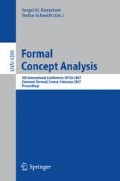Abstract
Different rule semantics have been successively defined in many contexts such as implications in artificial intelligence, functional dependencies in databases or association rules in data mining. We are interested in defining on tabular datasets a class of rule semantics for which Armstrong’s axioms are sound and complete, so-called well-formed semantics. The main contribution of this paper is to show that an equivalence does exist between some syntactic restrictions on the natural definition of a given semantics and the fact that this semantics is well-formed. From a practical point of view, this equivalence allows to prove easily whether or not a new semantics is well-formed. We also point out the relationship between our generic definition of rule satisfaction and the underlying data mining problem, i.e. given a well-formed semantics and a tabular dataset, discover a cover of rules satisfied in this dataset. This work takes its roots from a bioinformatics application, the discovery of gene regulatory networks from gene expression data.
Access this chapter
Tax calculation will be finalised at checkout
Purchases are for personal use only
Preview
Unable to display preview. Download preview PDF.
References
Armstrong, W.: Dependency structures of data base relationships. In: Proc. of the IFIP Congress 1974, pp. 580–583 (1974)
Ganter, B., Wille, R.: Formal Concept Analysis. Springer, Heidelberg (1999)
Agrawal, R., Imielinski, T., Swami, A.: Mining association rules between sets of items in large databases. In: ACM SIGMOD International Conference on Management of Data, Washington, D.C., pp. 207–216. ACM Press, C (1993)
Abiteboul, S., Hull, R., Vianu, V.: Fondements des bases de données, p. 715. Addison-Wesley, Reading (2000)
Beeri, C., Berstein, P.: Computational problems related to the design of normal form relation schemes. ACM TODS 4(1), 30–59 (1979)
Maier, D.: Minimum covers in the relational database model. JACM 27(4), 664–674 (1980)
Guigues, J.-L., Duquenne, V.: Familles minimales d’implications informatives résultant d’un tableau de données binaires. Math. Sci. Humaines 24(95), 5–18 (1986)
Gottlob, G., Libkin, L.: Investigations on Armstrong relations, dependency inference, and excluded functional dependencies. Acta Cybernetica 9(4), 385–402 (1990)
Icev, A., Ruiz, C., Ryder, E.F.: Distance-enhanced association rules for gene expression. In: BIOKDD’03, in conjunction with ACM SIGKDD, Washington, DC, USA, ACM Press, New York (2003)
Creighton, C., Hanash, S.: Mining gene expression databases for association rules. Bioinformatics 19, 79–86 (2003)
Cong, G., et al.: Farmer: Finding interesting rule groups in microarray datasets. In: Proc. of the ACM SIGMOD, pp. 143–154. ACM Press, New York (2004)
Mannila, H., Räihä, K.J.: Algorithms for inferring functional dependencies from relations. DKE 12(1), 83–99 (1994)
Demetrovics, J., Thi, V.: Some remarks on generating Armstrong and inferring functional dependencies relation. Acta Cybernetica 12(2), 167–180 (1995)
Ullman, J.D.: Principles of Database Systems. Computer Science Press, Rockville (1982)
Zaki, M.J.: Generating non-redundant association rules. In: Proceedings of the sixth ACM SIGKDD international conference on Knowledge discovery and data mining, Boston, Massachusetts, United States, pp. 34–43. ACM Press, New York (2000), doi:10.1145/347090.347101
Beeri, C., et al.: On the structure of Armstrong relations for functional dependencies. JACM 31(1), 30–46 (1984)
Bastide, Y., et al.: Mining minimal non-redundant association rules using frequent closed itemsets. In: Palamidessi, C., et al. (eds.) CL 2000. LNCS (LNAI), vol. 1861, pp. 972–986. Springer, Heidelberg (2000)
Huhtala, Y., et al.: Efficient discovery of functional and approximate dependencies using partitions. In: Proc. of the 14th IEEE ICDE, pp. 392–401. IEEE Computer Society Press, Los Alamitos (1998)
Klemettinen, M., et al.: Finding Interesting Rules from Large Sets of Discovered Association Rules. In: Proc. of the 3td CIKM, pp. 401–407 (1994)
Baralis, E., Psaila, G.: Designing templates for mining association rules. J. Intell. Inf. Syst. 9(1), 7–32 (1997)
Cristofor, L., Simovici, D.: Generating an informative cover for association rules. In: Proceedings of the 2002 IEEE ICDM, Japan, pp. 597–600. IEEE Computer Society Press, Los Alamitos (2002)
Li, G., Hamilton, H.: Basic association rules. In: Proceedings of the Fourth SIAM International Conference on Data Mining, Lake Buena Vista, Florida, USA, SIAM, Philadelphia (2004)
Luong, V.P.: The representative basis for association rules. In: IEEE ICDM’01, pp. 639–640. IEEE Computer Society Press, Los Alamitos (2001)
Tan, P.-N., Kumar, V., Srivastava, J.: Selecting the right objective measure for association analysis. Information Systems 29(4), 293–313 (2004)
Kivinen, J., Mannila, H.: Approximate inference of functional dependencies from relations. TCS 149(1), 129–149 (1995)
Saeed, A., et al.: TM4: a free, open-source system for microarray data management and analysis. Biotechniques 34(2), 374–378 (2003)
Author information
Authors and Affiliations
Editor information
Rights and permissions
Copyright information
© 2007 Springer Berlin Heidelberg
About this paper
Cite this paper
Agier, M., Petit, JM. (2007). A New and Useful Syntactic Restriction on Rule Semantics for Tabular Datasets. In: Kuznetsov, S.O., Schmidt, S. (eds) Formal Concept Analysis. ICFCA 2007. Lecture Notes in Computer Science(), vol 4390. Springer, Berlin, Heidelberg. https://doi.org/10.1007/978-3-540-70901-5_3
Download citation
DOI: https://doi.org/10.1007/978-3-540-70901-5_3
Publisher Name: Springer, Berlin, Heidelberg
Print ISBN: 978-3-540-70828-5
Online ISBN: 978-3-540-70901-5
eBook Packages: Computer ScienceComputer Science (R0)

